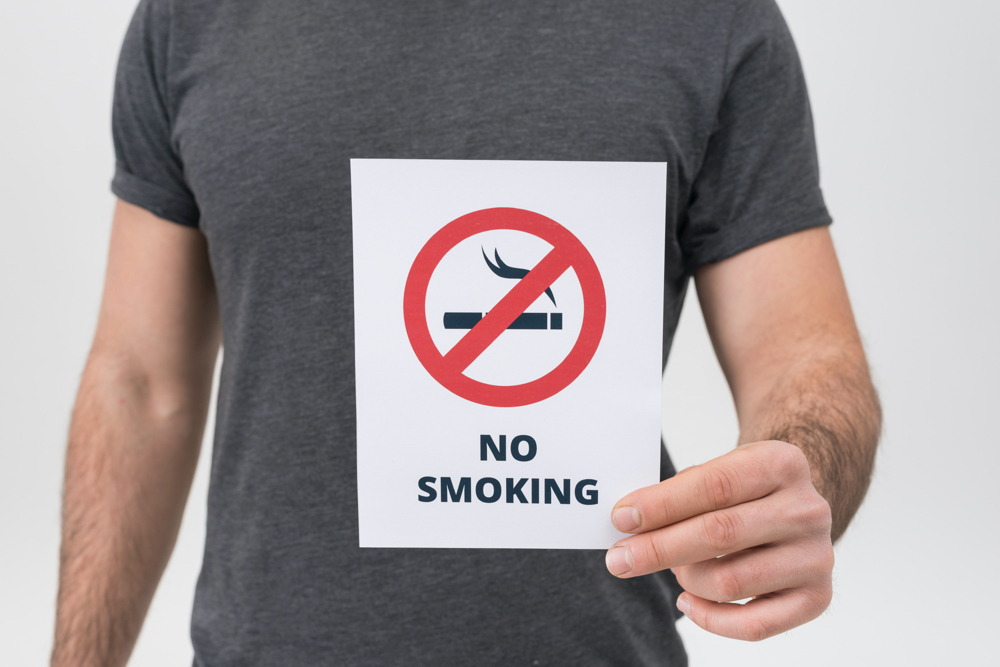- Fast results
- 4,000+ locations
- 4.8 star rating
Need Help? (888) GET LABS


Smoking habits bring tons of adverse health effects, from cardiovascular diseases to lung cancer. So, it’s no surprise that more people aim for smoking cessation yearly. However, this is no easy feat.
Smoking withdrawal can be a nightmare if you don’t know the proper steps to take. When managing cigarette withdrawal symptoms, you must keep your brain occupied, practice relaxation techniques, avoid triggers, try nicotine replacement products, seek counseling and support, and remind yourself of your big why.
Keep reading to learn how to undertake these actions and reduce the adverse effects of quitting smoking.
Pro Tip: Keeping track of how much nicotine (and its metabolites) is in your system makes for a better smoking cessation plan. It encourages you to deal with the side effects of quitting smoking when you see improvement in the levels of nicotine in your body. Get this crucial information when you take a nicotine blood test.
The nicotine you get from cigarettes, and other tobacco products change your brain over time. It stimulates pleasurable sensations by activating dopamine signals and forces your brain to add more nicotine receptors, accommodating the high daily volume you input in your system.
These internal events are why symptoms of quitting smoking become unbearable. Your brain got used to certain amounts of nicotine, and cutting it off will induce the following effects.
When these cigarette withdrawal symptoms start to emerge, people are often tempted to light a cigarette – which is why over 50% who did end up relapsing. But these side effects don’t last.
On average, you’ll experience withdrawal symptoms for three to four weeks. Eventually, they subside, and the longer you resist the urge for a cigarette, the easier it will become to abstain from smoking completely.
Did You Know? Nicotine is a stimulant that can also act as a depressant, contributing to its addictive nature. Other substances, like illicit drugs, have the same or even worse effect on the body. Check out our drugs and alcohol tests to see what chemicals should be screened.
You can’t expect to manage nicotine withdrawal without exerting some effort. But how effective these efforts are depends on the appropriate steps you take to address the unpleasant side effects of quitting smoking. Here are actions you can consider when managing nicotine withdrawal.

In the first three months of detoxing from smoking, your brain will try to push you to take “just one” cigarette. Smoking withdrawal symptoms magnify your urges, and it could be hard to resist if you just sit around.
Keep your head busy and away from the thought of smoking with the following activities:

Feeling irritable, anxious, and even depressed is common for smokers who are quitting the habit. If you dwell too much on these side effects, it could drive you to give in and puff a cigarette or impair your mental health altogether.
Recognize these feelings and fight them off through relaxation techniques like meditation and breathing exercises. If these side effects strike anytime during the day, pull yourself away from work or home and take deep breaths. Find areas in your place where you can practice guided mindfulness.
In cases where relaxation techniques are not working anymore, connect with a healthcare provider to help you out – whether via telehealth consultation or in-clinic appointment.

Adding regular exercise, regardless of type, into your daily routine surely has plenty of health benefits. However, previous researchers have mixed findings on whether this has a direct positive impact on smoking cessation.
Still, getting more physically active, either through exercise or sports, helps your brain think less about cigarettes. A 2020 study published in the Healthcare Journal shows that moderate-intensity exercises done for 10 minutes a day can help influence smoking cravings down. While the findings are novel, the psychological foundation links physical activity to diminishing smoking withdrawal symptoms.
Consider adding these light to moderate physical activities to your everyday schedule.

The last thing you want to be around when quitting smoking are potential triggers that will make you give in to the temptation. Triggers can be subjective, as certain factors can influence you more than others.
An example of possible smoking triggers is your social group. Suppose your friends are smokers, and you decided to spend time with them during your withdrawal period. In that case, there’s a good chance that you might relapse, especially if they’re less enthusiastic about your decision to quit.
Another trigger is a stressful situation or environment. If you’re under a lot of pressure at work and you’re ceasing smoking at the same time, you may become overwhelmed by the stressor and the smoking withdrawal symptoms. As a result, you’ll postpone quitting for another time.
To address these critical roadblocks, identify your smoking triggers. If it’s your friends, consider spending less time with them when you’re on withdrawal. Instead, be around non-smoking people who will encourage you.
If your trigger is stress at work, inform your supervisor about your smoking cessation. You may devise a less pressing way of dealing with work stress together. You can also consider taking a leave of absence. Whichever way you go, keep in mind that quitting cigarette smoking is for your long-term wellness and will always be worthwhile.

Going cold turkey on nicotine may do you more harm than good. You might get overwhelmed by tobacco withdrawal symptoms. While it may work with others, likely, it won’t have the same positive effects for you. So, instead of giving up nicotine in one blow, why not start by removing smoking and just gradually reduce nicotine circulation in your system?
You can use nicotine replacement products like nicotine gum, lozenges, patches, nasal sprays, and pills. For best results, consult with your doctor or program counselor.
Did You Know? Smoking withdrawal may seem straightforward, but it’s possible that you might not be doing it right. Read our guide on mistakes you should avoid when quitting smoking.

Aside from nicotine replacement products, keep your mouth busy by chewing on healthy food. Keep a bowl of nuts nearby, some carrots you can eat, celery, raisins (if you’re a fan), apples, pickles, and sugarless gum. If the cravings are strong, eat hard candy like butterscotch and cinnamon drops.
Additionally, pair these substitutes with water or herbal tea. Make sure you’re properly hydrated and not skipping any meals.

Quitting smoking is easier when you’re not doing it alone. Thankfully, you can access support outside your circle, which benefits smokers who lack social encouragement. You can visit your local community center to check for available counseling in your area. You can also check out the Centers for Disease Control and Prevention (CDC) quitline via 1-800-QUIT-NOW.
If you know people who have successfully quit smoking, connect with them. Also, inform your family and friends, especially those you know who can support you, check your progress, and celebrate your milestones. Being around those who value your lifestyle shift can empower you not to abandon your rehabilitation and recovery.

You don’t quit smoking without a “big why.” While others may get by with removing their smoking habits just because they don’t want to smoke anymore, this reasoning often leads to relapse. To truly establish your path toward a cigarette-free life, set a long-term goal that makes quitting smoking non-negotiable.
For example, your healthcare provider may have detected your high risk for cardiovascular disease. Preventing heart attacks can be your big reason. Or perhaps you’re trying to conceive a child, and your doctor encouraged you to stop smoking cigarettes.
Whatever your reason is, make sure you are constantly reminded about it. You can even create a visual representation of your goal—something you can hang in your room or office. Try using visual apps or setting your phone’s background image to what you want to achieve from quitting smoking.
Typically, tobacco withdrawal symptoms kick in three days after you stop using tobacco products – which is also dubbed as the hardest day of quitting smoking. It will last for about a month.
Within this time, and even a couple of months after that, you’ll need to fight the urge to smoke and manage the symptoms well, so you can continue your normal routine.
However, if the symptoms are too much for you to bear, seek counseling and/or use nicotine replacement products. A blood test can also assess how much nicotine and cotinine are left in your system.
Three months after smoking cessation, your dopamine is expected to return to normal. According to a previous study published in the Biological Psychiatry Journal, dopamine activation reduces over time when you quit smoking. On average, it takes about 12 weeks to reduce dopamine, influencing smoking cravings.
There’s no single path to successfully quitting smoking. You must employ more than one, if not all, of the recommended ways to manage cigarette withdrawal symptoms.
There is no shame in admitting it’s difficult to stop smoking or that you need help in doing so. While you may be able to do specific actions by yourself, you will still need the support of your family, social group, and even a dedicated community for recovering smokers to keep you on the right track.
Giving up a habit that has changed your brain chemistry can become extra challenging, especially if you have no idea what impacts it brings to your physical and mental health. Still, when you quit smoking, the rewards, in the end, are more valuable than giving in to the temptation of “one last cigarette.”
There are many success stories involving cigarette withdrawal. You can add yours soon when you follow these practical ways of managing nicotine withdrawal.

© Copyright 2025 Personalabs. All Rights Reserved.